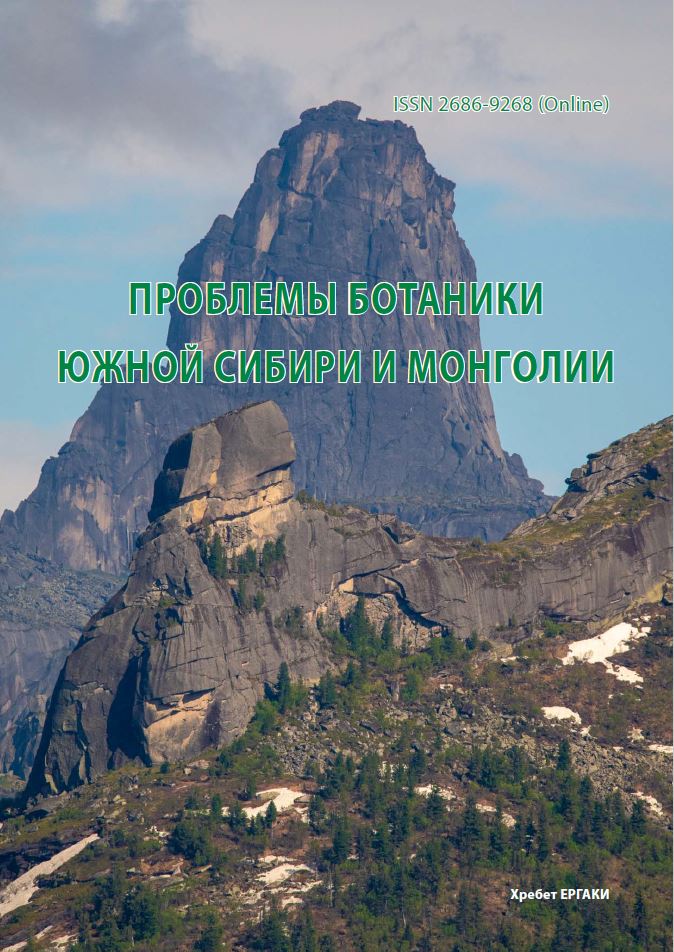Diversity in the morphology of clones of witches’ broom in Siberian stone pine
УДК 582.475:581.41*630
Abstract
Mutational witches’ broom (WB) is a fragment of a tree crown with abnormally dense branching and slow shoot growth compared with those of a normal crown. All WBs have thicker and denser crown compared to the normal crown part of their parental tree, but the crown density differs significantly among WBs. There are both relatively loose WBs, whose crown density differ from normal crown part not very strong, and WBs with a very dense crown. The aim of this study was to conduct a comparative analysis of morphological traits in Pinus sibirica WB clones with different crown densities and to determine which traits contribute most to their differences. The object of the study was clones from 11 mutational WB with different crown density. The density of WB was considered low if it exceeded the density of a normal crown by less than 2 times, medium - by 2-3 times, high - by more than 3 times. Morphological characteristics of crown and shoots were measured in 12-year-old clones. It was found that the higher the WB clone crown density the smaller and less elongated its crown shape, as well as less crown continuity. The basis of this phenotype formation was primarily the shorter length of annual shoots, the reduced level of apical dominance compared to other clone groups, and advanced branching. An additional factor that increased crown density was the significantly shorter internodes compared to the other clone groups. The needle length did not contribute to the differences in crown density of the clones.
Downloads
Metrics
References
Носков В. И., Негруцкий С. Ф. К вопросу о происхождении «ведьминых метел» на сосне // Научные записки Воронежского лесотехн. ин-та, 1956. - Т. 15. - С. 207-210.
Понкратьева С. В., Ямбуров М. С. «Ведьмины метла» мутационного типа на примере ели сибирской (Picea obovata Ledeb.) как потенциал для развития декоративных древесных в Сибири // Cельскохозяйственные науки и агропромышленный комплекс на рубеже веков, 2015. - Т. 9. - C. 142-146.
Ямбуров М. С., Горошкевич С. Н. «Ведьмины метлы» кедра сибирского как спонтанные соматические мутации: встречаемость, свойства и возможности использования в селекционных программах // Хвойные бореаль-ной зоны, 2007. - T. XXIV, № 2-3. - С. 317-324.
Ямбуров М. С., Горошкевич С. Н., Третьякова И. Н., Хихлова О. В., Лукина А. В. «Ведьмины мётлы» мутационного типа как перспективный источник для получения новых декоративных форм хвойных растений // Научно-практический журнал «Вестник ИрГСХА», 2011. -Т. 44. - С. 153-160.
Buckland D. C., Kuijt J. Unexplained brooming of Douglas-fir and other conifers in British Columbia and Alberta // For Sci, 1957. - Vol. 3. - Р. 236-242.
Duffield J., Wheat J. Dwarf seedlings from broomed douglas-fir // Silvae Genet, 1963. - Vol. 12. - Р. 129-133.
Farjon A. Handbook of the World’s Conifers. - Leiden: Brill Academic Publishers, Leiden, 2010. - 1150 p. Fordham A. J. Dwarf conifers from witches’-brooms // Arnoldia, 1967. - Vol. 24. - Р. 29-50.
Hoshi A., Oshima K., Kakizawa S., Ishii Y., Ozeki J., Hashimoto M., Komatsua K., Kagiwadab S., Yamajia Y., Namba S. A unique virulence factor for proliferation and dwarfism in plants identified from a phytopathogenic bacterium // Proc Natl Acad Sci USA, 2009. - Vol. 106. - Р. 6416-6421. DOI: 10.1073/pnas.0813038106.
Scarpari L. M., Meinhardt L. W., Mazzafera P., Pomella A. W., Schiavinato M. A., Cascardo J. C., Pereira G. A. Biochemical changes during the development of witches’ broom: the most important disease of cocoa in Brazil caused by Crinipellis perniciosa // J Exp Bot, 2005. - Vol. 56, № 413. - Р. 865-877. DOI: 10.1093/jxb/eri079.
Seo J. K., Kim M. K., Kwak H. R., Kim J. S., Choi H. S. Complete genome sequence of longan witches’ broom-associated virus, a novel member of the family Potyviridae // Arch Virol, 2017. - Vol. 162. - Р. 2885-2889. DOI: 10.1007/ s00705-017-3405-2.
Sugio A., MacLean A. M., Kingdom H. N., Grieve V. M., Manimekalai R., Hogenhout S. A. Diverse targets of phytoplasma effectors: from plant development to defense against insects // Annu Rev Phytopathol, 2011. - Vol. 49. -Р. 175-195. DOI: 10.1146/annurev-phyto-072910-095323.
Vrgoc P. Witches’ broom of Aleppo pine (Pinus halepensis Mill.) and its use for new ornamentals // XX International Eucarpia Symposium, Section Ornamentals, Strategies for New Ornamentals - Part II (3 July, 2001., Melle, Ghent (Belgium)). - Acta Horticulturae, 2002. - Р. 199-205.
Zhuk E., Vasilyeva G., Goroshkevich S. Witches’ broom and normal crown clones from the same trees of Pinus sibirica: a comparative morphological study // Trees, 2015. - Vol. 29. - Р. 1079-1090. DOI: 10.1007/s00468-015-1187-2.
Zhuk E., Vasilyeva G., Goroshkevich S. Mutational witches’ broom impact on the growth of the parent branch in several Pinaceae species // Dendrobiology, 2020. - Vol. 83. - Р. 52-59. DOI: 10.12657/denbio.083.005.



